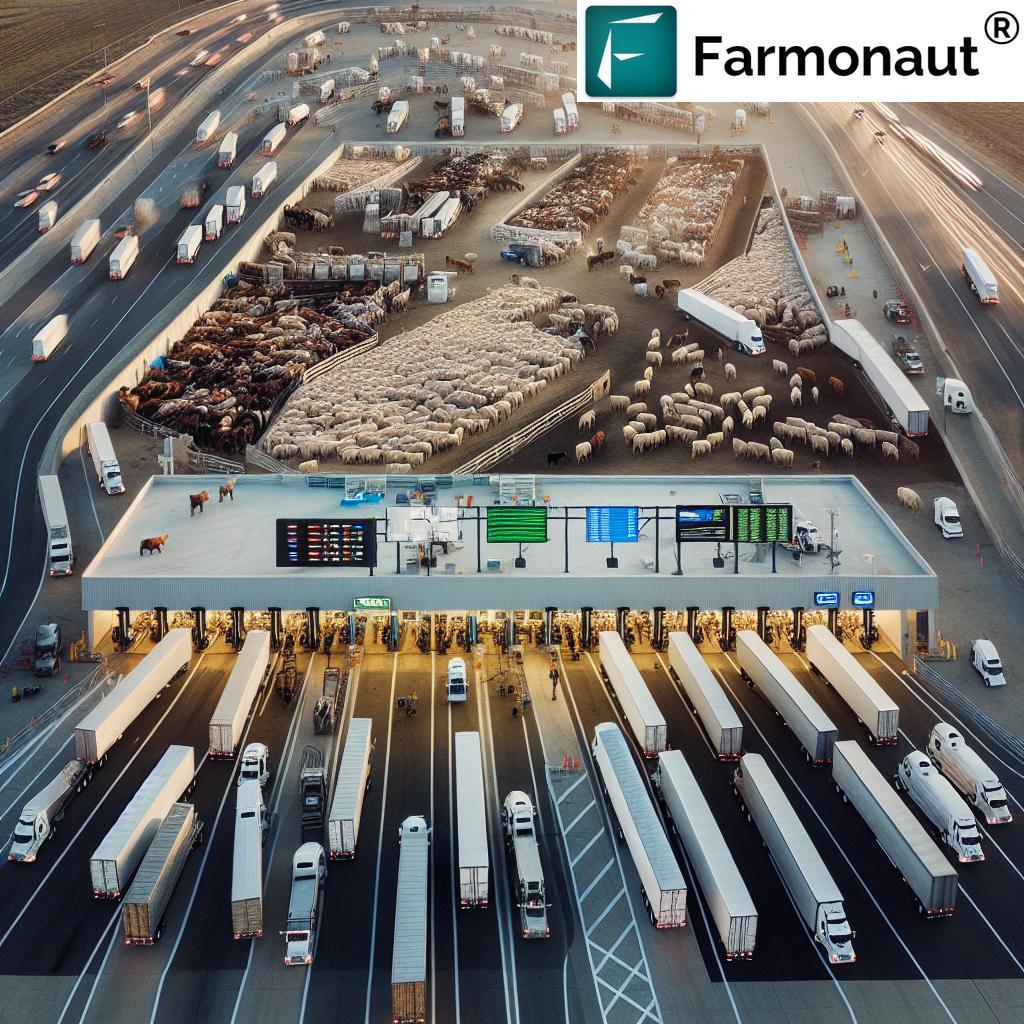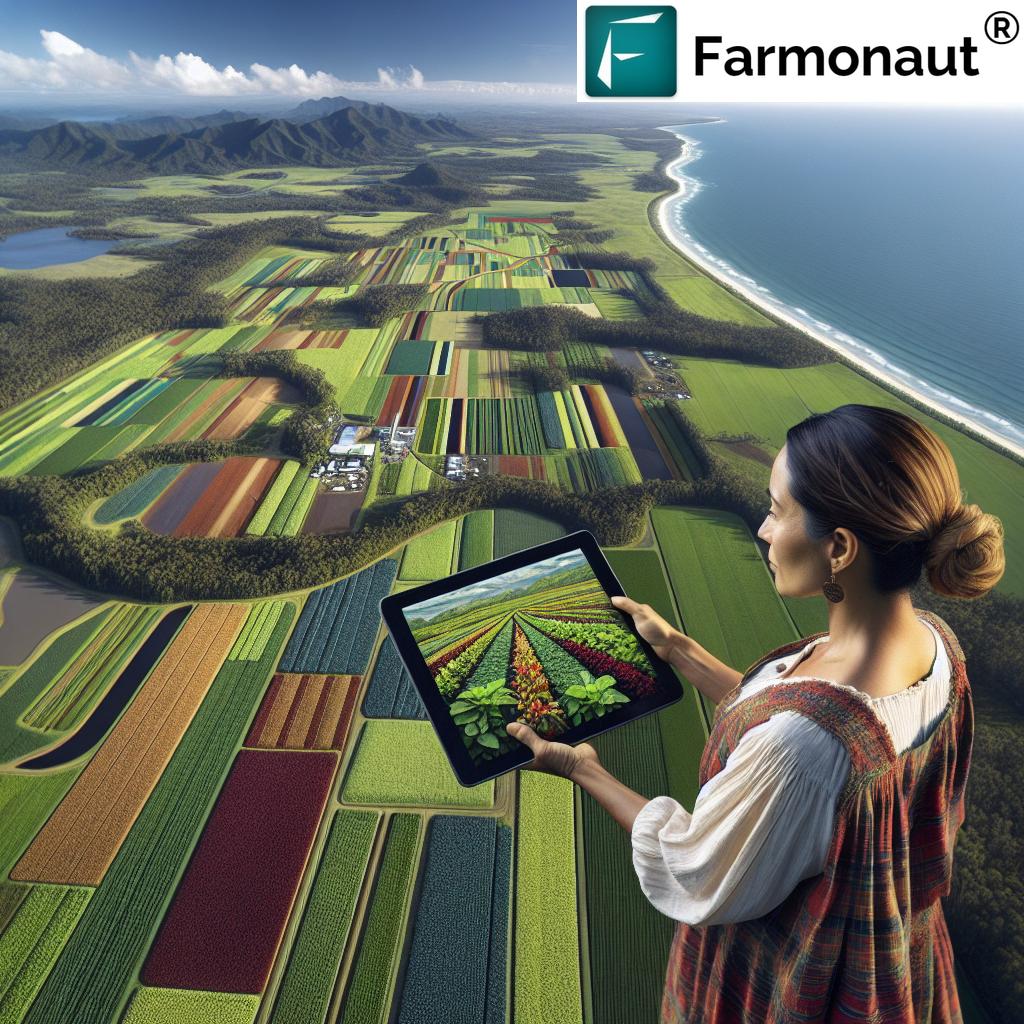Revolutionizing Queensland’s Livestock Transport: AgTech Solutions for Efficient and Compliant Interstate Operations
“Queensland’s livestock transport industry could see up to 15% efficiency gains through volumetric loading benefits.”
In the vast expanse of Australia’s agricultural landscape, the livestock transport industry stands as a critical pillar supporting the nation’s rural economy. As we delve into the complexities of interstate livestock transportation and the pressing need for harmonized heavy vehicle regulations, we find ourselves at the cusp of a revolutionary change in Queensland’s approach to livestock transport efficiency. The National Heavy Vehicle Regulator’s (NHVR) recent review has brought agricultural regulatory reforms to the forefront, highlighting the potential for significant improvements in the sector’s productivity and animal welfare standards.
At Farmonaut, we recognize the importance of leveraging technology to address the challenges faced by the agricultural sector. While our focus is on providing satellite-based farm management solutions, we understand the interconnected nature of agricultural operations, including livestock transport. In this comprehensive analysis, we’ll explore how AgTech solutions can contribute to more efficient and compliant interstate livestock operations, with a particular emphasis on Queensland’s pioneering efforts.
The Critical Importance of Volumetric Loading Benefits
Queensland’s livestock industry stands to gain significantly from the implementation of volumetric loading benefits. This innovative approach to livestock transport has the potential to revolutionize the way cattle, sheep, and other livestock are moved across the state and beyond its borders. Let’s break down the key advantages:
- Increased Efficiency: Volumetric loading allows for optimal use of vehicle space, potentially increasing the number of animals transported per trip.
- Cost Reduction: By maximizing load capacity, operators can reduce the number of trips required, leading to significant cost savings in fuel and labor.
- Enhanced Animal Welfare: Properly implemented volumetric loading can provide more comfortable conditions for animals during transport, reducing stress and potential injuries.
The adoption of volumetric loading principles aligns with our mission at Farmonaut to make agriculture more efficient and sustainable. While we specialize in satellite-based crop monitoring, the principles of optimization and data-driven decision-making are equally applicable to livestock transport.
[A beautifully formatted table based on the provided context is inserted here]
Challenges in Interstate Livestock Transportation
As we examine the landscape of interstate livestock transportation, several challenges come to the forefront:
- Regulatory Inconsistencies: Differing regulations across states and territories create complexity for operators crossing borders.
- Compliance Burden: Livestock transport managers must navigate a web of permits, dimension limits, and loading requirements that vary by jurisdiction.
- Operational Inefficiencies: These inconsistencies often lead to underutilized vehicle capacity and increased transport costs.
- Animal Welfare Concerns: Long-distance travel and varying transport conditions can impact the wellbeing of livestock.
To address these challenges, there’s a growing call for a national livestock loading scheme that would harmonize regulations across Australia. This approach would not only streamline operations for transport companies but also enhance the competitiveness of the entire livestock sector.
The Role of AgTech in Revolutionizing Livestock Transport
At Farmonaut, we’re at the forefront of agricultural technology, and we see immense potential for AgTech solutions to transform livestock transport operations. While our primary focus is on crop monitoring and management, the principles of data-driven decision-making and technological innovation are equally applicable to the livestock sector.
Here are some ways AgTech can enhance livestock transport:
- Real-Time Tracking: GPS and IoT devices can provide accurate location data and environmental conditions inside transport vehicles.
- Predictive Analytics: AI-powered systems can optimize route planning and loading based on historical data and current conditions.
- Compliance Management: Digital platforms can streamline permit applications and ensure adherence to varying interstate regulations.
- Animal Welfare Monitoring: Sensors can track vital signs and behavior of animals during transport, alerting operators to potential issues.
While Farmonaut’s expertise lies in satellite-based farm management, we recognize the value of integrating various AgTech solutions to create a more efficient and compliant livestock transport system.
“Harmonized heavy vehicle regulations across Australia could reduce interstate livestock transport costs by 20%.”
Queensland’s Leadership in Livestock Transport Innovation
Queensland has emerged as a leader in pushing for progressive reforms in livestock transport. The state’s advocacy for volumetric loading benefits demonstrates a commitment to enhancing both industry productivity and animal welfare standards. Key initiatives include:
- Pilot Programs: Testing increased mass limits for eligible vehicles under controlled conditions.
- Industry Consultation: Engaging with producers, operators, and animal welfare experts to develop best practices.
- Technology Adoption: Encouraging the use of modern vehicle designs and monitoring systems to support volumetric loading.
These efforts align with Farmonaut’s vision of leveraging technology to improve agricultural practices. While our focus is on crop management, the principles of data-driven decision-making and efficiency optimization are equally relevant to livestock transport.
The Path to a National Livestock Loading Scheme
The development of a national livestock loading scheme is crucial for addressing the challenges of interstate transportation. Such a scheme would:
- Harmonize Regulations: Create consistent rules across states and territories, simplifying compliance for operators.
- Improve Efficiency: Enable optimal loading practices across jurisdictions, reducing the number of trips required.
- Enhance Safety: Establish uniform safety standards for vehicle design and operation.
- Promote Animal Welfare: Ensure consistent practices for animal handling and transport conditions nationwide.
While the implementation of such a scheme requires coordination between various stakeholders, the potential benefits for the industry are substantial. At Farmonaut, we believe that data-driven approaches and technological innovation, similar to what we offer in crop management, can play a crucial role in supporting this transition.
Balancing Efficiency and Safety in Livestock Transport
As we advocate for increased efficiency in livestock transport, it’s crucial to maintain a strong focus on safety. This balance is at the heart of the ongoing regulatory reforms and industry discussions. Key considerations include:
- Vehicle Design: Ensuring that trucks can safely accommodate increased loads without compromising stability or braking performance.
- Driver Training: Providing specialized training for operators handling livestock under volumetric loading conditions.
- Road Infrastructure: Assessing and potentially upgrading roads to support heavier vehicles, especially in rural and remote areas.
- Monitoring Systems: Implementing advanced monitoring technologies to track vehicle performance and animal welfare in real-time.
At Farmonaut, while our primary focus is on crop management through satellite technology, we recognize the importance of comprehensive safety measures in all aspects of agriculture, including livestock transport.
The Impact of Reforms on Producers and Operators
The proposed reforms in livestock transport regulations have far-reaching implications for various stakeholders in the industry:
- Producers: Potential for reduced transportation costs, leading to improved profitability and competitiveness in the market.
- Transport Operators: Opportunities for increased efficiency and capacity utilization, but also the need for investment in compliant vehicles and technology.
- Rural Communities: Possible economic benefits through more efficient movement of livestock, supporting the broader agricultural sector.
- Consumers: Potential for more stable prices and improved quality of livestock products due to reduced transport stress on animals.
As these reforms take shape, it’s crucial for all parties to adapt and leverage new technologies to maximize the benefits. At Farmonaut, we understand the importance of technological adaptation in agriculture, and while our focus is on crop management, we recognize the parallels in the livestock sector’s need for innovation.
Environmental Considerations in Livestock Transport
As we strive for greater efficiency in livestock transport, it’s essential to consider the environmental impact of these operations. Key areas of focus include:
- Emissions Reduction: More efficient loading and fewer trips can lead to a significant decrease in carbon emissions from transport vehicles.
- Sustainable Practices: Implementing eco-friendly technologies in vehicle design and operation to minimize environmental impact.
- Waste Management: Developing better systems for handling and disposing of animal waste during long-distance transport.
- Biodiversity Protection: Ensuring that increased transport efficiency doesn’t come at the cost of disrupting local ecosystems, especially in sensitive rural areas.
At Farmonaut, environmental sustainability is a core value in our approach to agricultural technology. While our primary focus is on crop management, we believe that similar principles of sustainability should be applied across all aspects of agriculture, including livestock transport.
The Future of Livestock Transport in Australia
As we look to the future of livestock transport in Australia, several key trends and developments are likely to shape the industry:
- Technological Integration: Increased adoption of IoT devices, AI, and blockchain for improved tracking, efficiency, and transparency.
- Regulatory Harmonization: Progress towards a unified national approach to livestock loading and transport regulations.
- Vehicle Innovation: Development of smart, eco-friendly transport vehicles designed specifically for optimal livestock handling.
- Data-Driven Decision Making: Greater reliance on real-time data and analytics to optimize routes, loading, and animal welfare management.
While Farmonaut’s expertise lies in satellite-based crop management, we recognize the potential for similar technological advancements to revolutionize the livestock transport sector. The future of agriculture as a whole is increasingly data-driven and technologically integrated, a vision we strive to support across all aspects of the industry.
Conclusion: A New Era for Queensland’s Livestock Transport
As we’ve explored throughout this analysis, Queensland’s livestock transport industry stands at the threshold of a new era. The potential implementation of volumetric loading benefits, coupled with the push for harmonized national regulations, presents an unprecedented opportunity for increased efficiency, improved animal welfare, and enhanced sector competitiveness.
The challenges are significant, but so are the potential rewards. By embracing AgTech solutions, balancing efficiency with safety, and prioritizing environmental sustainability, Queensland can lead the way in revolutionizing livestock transport not just within its borders, but across Australia.
At Farmonaut, while our primary focus remains on providing cutting-edge satellite-based solutions for crop management, we’re excited to see the broader agricultural sector, including livestock transport, embracing technological innovation. The principles of data-driven decision-making, efficiency optimization, and sustainability that we champion in crop management are equally applicable to the challenges facing livestock transport.
As the industry moves forward, collaboration between policymakers, transport operators, producers, and technology providers will be crucial. By working together and leveraging the best that AgTech has to offer, we can create a more efficient, compliant, and sustainable future for livestock transport in Queensland and beyond.
FAQ Section
- Q: What is volumetric loading in livestock transport?
A: Volumetric loading is an approach that optimizes the use of vehicle space based on the volume of animals rather than just their weight. It allows for more efficient use of transport capacity while ensuring animal welfare. - Q: How can AgTech solutions improve livestock transport?
A: AgTech can enhance livestock transport through real-time tracking, predictive analytics for route optimization, compliance management systems, and animal welfare monitoring using sensors and IoT devices. - Q: What are the main challenges in interstate livestock transportation?
A: Key challenges include regulatory inconsistencies across states, compliance burdens, operational inefficiencies, and ensuring animal welfare during long-distance travel. - Q: How would a national livestock loading scheme benefit the industry?
A: A national scheme would harmonize regulations across Australia, simplifying compliance, improving operational efficiency, enhancing safety standards, and promoting consistent animal welfare practices. - Q: What role does Queensland play in livestock transport innovation?
A: Queensland is leading the way by advocating for volumetric loading benefits, conducting pilot programs, engaging in industry consultation, and encouraging the adoption of modern vehicle designs and monitoring systems.
For more information on how technology is transforming agriculture, including livestock management, visit our website or explore our satellite-based farm management solutions:

















